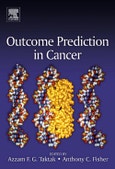This book is organized into 4 sections, each looking at the question of outcome prediction in cancer from a different angle. The first section describes the clinical problem and some of the predicaments that clinicians face in dealing with cancer. Amongst issues discussed in this section are the TNM staging, accepted methods for survival analysis and competing risks. The second section describes the biological and genetic markers and the rôle of bioinformatics. Understanding of the genetic and environmental basis of cancers will help in identifying high-risk populations and developing effective prevention and early detection strategies. The third section provides technical details of mathematical analysis behind survival prediction backed up by examples from various types of cancers. The fourth section describes a number of machine learning methods which have been applied to decision support in cancer. The final section describes how information is shared within the scientific and medical communities and with the general population using information technology and the World Wide Web.
Please Note: This is an On Demand product, delivery may take up to 11 working days after payment has been received.
Table of Contents
Section 1 The Clinical Problem.THE PREDICTIVE VALUE OF DETAILED HISTOLOGICAL STAGING OF SURGICAL RESECTION SPECIMENS IN ORAL CANCER
Chapter 1: The predictive value of detailed histological staging of surgical resection specimens in oral cancer.
J. Woolgar
Liverpool Dental School, UK
Chapter 2: Survival after Treatment of Intraocular Melanoma.
B.E. Damato, A.F.G. Taktak,
Royal Liverpool University Hospital, UK
Chapter 3: Recent developments in relative survival analysis.
T. Hakulinen, T.A. Dyba,
Finnish Cancer Registry
Section 2 Biological and Genetic Factors
Chapter 4: Environmental and genetic risk factors of lung cancer.
A. Cassidy, J.K. Field,
University of Liverpool, UK
Chapter 5: Chaos, cancer, the cellular operating system and the prediction of survival in head and neck cancer.
A.S. Jones,
University Hospital Aintree, UK
Section 3 Mathematical Background of Prognostic Models
Chapter 6: Flexible hazard modelling for outcome prediction in cancer perspectives for the use of bioinformatics knowledge.
E.Biganzoli1, P. Boracchi2
1 Istituto Nazionale per lo Studio e la Cura dei Tumori, Milano, Italy
2 Università degli Studi di Milano, Milano, Italy
Chapter 7: Information geometry for survival analysis and feature selection by neural networks.
A. Eleuteri 1,2, R. Tagliaferri 3,4, L. Milano 1,2, M. De Laurentiis 1
1Università di Napoli, Italy
2INFN sez. Napoli, Italy
3Universit`a di Salerno, Italy
4INFN sez. distaccata di Salerno, Italy
Chapter 8: Artificial neural networks used in the survival analysis of breast cancer patients: A node negative study.
C.T.C. Arsene, P.J. Lisboa,
Liverpool John Moores University, UK
Section 4 Application of Machine Learning Methods
Chapter 9: The use of artificial neural networks for the diagnosis and estimation of prognosis in cancer patients.
A. Marchevsky,
Cedars-Sinai Medical Center, Los Angeles, USA
Chapter 10: Machine learning contribution to solve prognosis medical problems.
F. Baronti, A. Micheli, A. Passaro, A.Starita,
University of Pisa, Italy
Chapter 11: Classification of brain tumours by pattern recognition of Magnetic Resonance Imaging and Spectroscopic data.
A. Devos1, S. Van Huffel1 A.W. Simonetti1, M. van der Graaf2, A. Heerschap2, L.M.C. Buydens3
1Katholieke Universiteit Leuven, Belgium
2University Nijmegen Medical Centre, The Netherlands
3Radboud University Nijmegen, The Netherlands
Chapter 12: Towards automatic risk analysis for hereditary non-polyposis colorectal cancer based on pedigree data.
M. Kokuer1, R.N.G. Naguib1, P. Jancovic2, H.B. Younghusband3, R. Green3
1Coventry University, UK
2University of Birmingham, UK
3University of Newfoundland, Canada
Chapter 13: The impact of microarray technology in brain cancer.
M. Kounelakis1, M. Zervakis1, X. Kotsiakis2
1Technical University of Crete, GREECE
2District Hospital of Chania, GREECE
Section 5 Dissemination of Information
Chapter 14: The web and the new generation of medical information.
J.M. Fonseca, A.D. Mora, P. Barroso
University of Lisbon, Portugal
Chapter 15: Geoconda: a web environment for multi-centre research.
C. Setzkorn, A.F.G. Taktak, B.E. Damato
Royal Liverpool University Hospital, Liverpool, UK
Chapter 16: The development and execution of medical prediction models.
M.W. Kattan1, M. Gönen2, P.T. Scardino2
1The Cleveland Clinic Fondation, Cleveland, USA
2Memorial Sloan-Kettering Cancer Center, New York, USA








